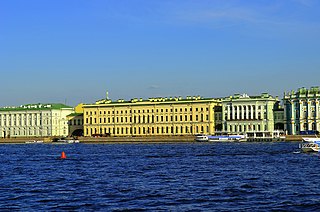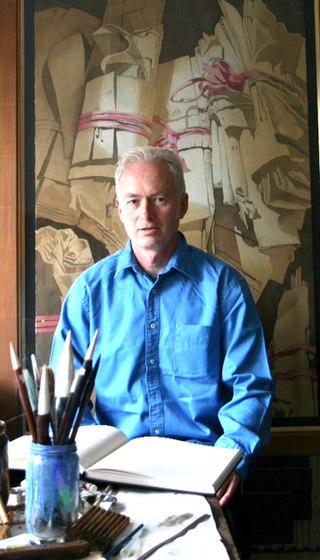
The National is the national art gallery of Scotland. It is located on The Mound in central Edinburgh, close to Princes Street. The building was designed in a neoclassical style by William Henry Playfair, and first opened to the public in 1859.

Holyrood Abbey is a ruined abbey of the Canons Regular in Edinburgh, Scotland. The abbey was founded in 1128 by David I of Scotland. During the 15th century, the abbey guesthouse was developed into a royal residence, and after the Scottish Reformation the Palace of Holyroodhouse was expanded further. The abbey church was used as a parish church until the 17th century, and has been ruined since the 18th century. The remaining walls of the abbey lie adjacent to the palace, at the eastern end of Edinburgh's Royal Mile. The site of the abbey is protected as a scheduled monument.


The State Hermitage Museum is a museum of art and culture in Saint Petersburg, Russia. It is the second largest art museum in the world by gallery space. It was founded in 1764 when Empress Catherine the Great acquired a collection of paintings from the Berlin merchant Johann Ernst Gotzkowsky. The museum celebrates the anniversary of its founding each year on 7 December, Saint Catherine's Day. It has been open to the public since 1852. The Art Newspaper ranked the museum 6th in their list of the most visited art museums, with 1,649,443 visitors in 2021.

Holyrood Park is a royal park in central Edinburgh, Scotland about 1 mile to the east of Edinburgh Castle. It is open to the public. It has an array of hills, lochs, glens, ridges, basalt cliffs, and patches of gorse, providing a wild piece of highland landscape within its 650-acre (260 ha) area. The park is associated with the royal palace of Holyroodhouse and was formerly a 12th-century royal hunting estate. The park was created in 1541 when James V had the ground "circulit about Arthurs Sett, Salisborie and Duddingston craggis" enclosed by a stone wall.

The Queen's Gallery is the public art gallery of Buckingham Palace, the official residence of the British monarch, in London. First opened to the public in 1962, it exhibits works of art from the Royal Collection on a rotating basis. Enlarged in the early 21st century, the gallery has its own separate public access entrance built in a 'new' classical style and typically displays about 450 works, mainly paintings and drawings.
The High Constables of Holyroodhouse are a small corps of ceremonial bodyguards at the Sovereign's official residence in the Scottish capital, Edinburgh. Created in the early sixteenth century to protect the Monarch in residence at Holyrood, as well as to guard the Palace and Abbey, and enforce law and order within the precincts of the Palace and the Holyrood Abbey Sanctuary.

The Madonna of the Yarnwinder is a subject depicted by Leonardo da Vinci in at least one, and perhaps two paintings begun in 1499 or later. Leonardo was recorded as being at work on one such picture in Florence in 1501 for Florimond Robertet, a secretary to King Louis XII of France. This may have been delivered to the French court in 1507, though scholars are divided on this point. The subject is known today from several versions of which two, called the Buccleuch Madonna and the Lansdowne Madonna, are thought to be partly by Leonardo's hand. The underdrawings of both paintings show similar experimental changes made to the composition, suggesting that both evolved concurrently in Leonardo's workshop.

Abbeyhill is an area of Edinburgh, the capital of Scotland.

Holyrood is an area in Edinburgh, the capital of Scotland, lying east of the city centre, at the foot of the Royal Mile.

The Royal Collection of the British royal family is the largest private art collection in the world.

The Palace of Holyroodhouse, commonly referred to as Holyrood Palace or Holyroodhouse, is the official residence of the British monarch in Scotland. Located at the bottom of the Royal Mile in Edinburgh, at the opposite end to Edinburgh Castle, Holyroodhouse has served as the principal royal residence in Scotland since the 16th century, and is a setting for state occasions and official entertaining.
William MacDowall was a Scottish priest and Master of Works to Mary, Queen of Scots, her mother Mary of Guise, and James VI of Scotland. The title 'sir' was used in Scotland by a priest without a master's degree. The name appears variously as McDowgall, McDougall, McDowall etc., in printed records, he signed accounts MAKDOUELL.

Meadowbank Parish Church is a congregation of the Church of Scotland in Edinburgh, Scotland. It is based in a late-Victorian church building on London Road, Abbeyhill, around 0.5 miles (0.80 km) north of Holyrood Abbey. The church building was opened in December 1900 as Abbeyhill United Free Church.

Jacob Jacobsz de Wet II, also known as James de Witt, was a Dutch Golden Age painter known for a series of 110 portraits of Scottish monarchs, many of them mythical, produced for the Palace of Holyroodhouse, Edinburgh during the reign of Charles II.

Salvator Mundi is a painting attributed in whole or in part to the Italian High Renaissance artist Leonardo da Vinci, dated to c. 1499–1510. Long thought to be a copy of a lost original veiled with overpainting, it was rediscovered, restored, and included in a major exhibition of Leonardo's work at the National Gallery, London, in 2011–2012. Christie's stated just after selling the work in 2017 that most leading scholars consider it to be an original work by Leonardo, but this attribution has been disputed by other leading specialists, some of whom propose that he only contributed certain elements; and others who believe that the extensive damage prevents a definitive attribution.

The Ruins of Holyrood Chapel is an oil on canvas painting of the Holyrood Abbey completed around 1824 by the French artist Louis Daguerre. The painting measures 211 × 256.3 cm (83.1 × 100.9 in), and is exhibited at the Walker Art Gallery in Liverpool, England. The museum acquired it in 1864.

Hugh Buchanan is a Scottish watercolour painter, renowned for his detailed draughtsmanship and treatment of light and shadows in interiors, and for a sense of depth and space that is reminiscent of the work of Cotman and Piranesi.
Charles Harris is a British painter, art instructor and teacher.

















